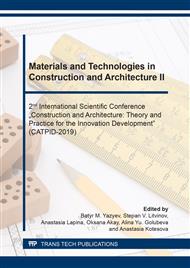[1]
M.P. Nazhuev, A.V. Yanovskaya, M.G. Kholodniak, A.K. Khalyushev, E.M. Shcherban, S.A. Stelmakh, Studying the experience of regulating the properties of building products and structures by directing the formation of their variational structure, Engineering journal of Don. 3 (2017).
Google Scholar
[2]
L.R. Mailyan, S.A. Stel'makh, M.G. Holodnyak, E.M. Shcherban, Choice of fiber types for disperse reinforcement of products from centrifuged concrete, Naukovedenie. 4 (2017).
Google Scholar
[3]
S.A. Stelmakh, E.M. Shcherban, K.V. Serdyukov, M.M. Pestrikov, A.V. Yanovskaya, Influence of some characteristics of the applied coarse aggregate on the properties of heavy concrete, designed for manufacturing centrifuged products and constructions, Bulletin of BSTU named after V.G. Shukhov. 10 (2017) 15-20.
DOI: 10.12737/article_59cd0c582d6879.33827530
Google Scholar
[4]
L.R. Mailyan, S.A. Stelmakh, M.G. Holodnyak, E.M. Shcherban, Selection of the composition of centrifuged concrete on heavy fillers, Bulletin of BSTU named after V.G. Shukhov. 10 (2017) 52-57.
DOI: 10.12737/article_59cd0c5972afe5.94172861
Google Scholar
[5]
L.R. Mailyan, S.A. Stelmakh, M.G. Holodnyak, E.M. Shcherban, Research of different types of centrifuges and modes in consolidation of concrete mixes for making samples of annular cross-section, Scientific bulletin SevKavGTI. 3 (2017) 134-137.
Google Scholar
[6]
S.A. Stel'makh, E.M. Shcherban, A.I. Shuyskiy, M.P. Nazhuev, Theoretical and practical aspects of the formation of the variational structure in centrifuged products from heavy concrete, materials science forum. 931 (2018) 502-507.
DOI: 10.4028/www.scientific.net/msf.931.502
Google Scholar
[7]
A.I. Shuyskiy, S.A. Stelmakh, E.M. Shcherban, M.G. Kholodnyak, Influence investigation of the initial composition of heavy concrete designed for the manufacture of ring-section products on its properties, Materials Science Forum. 931 (2018) 508-514.
DOI: 10.4028/www.scientific.net/msf.931.508
Google Scholar
[8]
S.A. Stelmakh, E.M. Shcherban, O.A. Zholobova, Prescription and technological aspects of manufacturing high-quality centrifuged products and structures from heavy concrete, IOP Conference Series: Materials Science and Engineering. 463 (2018).
DOI: 10.1088/1757-899x/463/2/022056
Google Scholar
[9]
A.A. Chernilnik, E.M. Shcherban, S.A. Stelmakh, S.V. Cheburakov, D.M. Elshaeva, N.A. Dotsenko, Setting and technological aspects of obtaining high-quality centrifuged concrete, Engineering journal of Don. 1 (2019).
Google Scholar
[10]
E.M. Shcherban, S.A. Stelmakh, M.P. Nazhuev, A.S. Nasevich, V.E. Geraskina, A.B. Poshev, The effect of various types of fibers on the physical mechanical properties of centrifuged concrete, The Eurasian scientific journal. 6 (2018).
Google Scholar
[11]
V.G. Pashkovskiy, Influence of the temperature factor on the cracks formation and development in the CN Supports, Transport Construction. 8 (1964) 45-46.
Google Scholar
[12]
N.V. Mikhaylov, V.G. Pashkovskiy, Problem of longitudinal cracks in centrifuged supports, Electrical construction. 2 (1967) 60−66.
Google Scholar
[13]
V.A. Nevskiy, Prediction of the concrete durability with alternating effects of the environment, Taking into account its structure and deformative properties, Мoscow, (1984).
Google Scholar
[14]
V.A. Nevskiy, Yu.V. Fedorenko, E.I. Lysenko, V.P. Petrov, V.P. Shurygin, Combined aggregates in centrifugal concrete, Transport Construction. 7 (1983) 30-31.
Google Scholar
[15]
V.P. Petrov, E.I. Lysenko, G.A. Tkachenko, V.P. Shurygin, Concrete with combined aggregate in the production of centrifuged contact network poles, Transport Construction. 10 (1983) 32.
Google Scholar
[16]
V.P. Petrov, Technology and properties of centrifuged concrete with the combined aggregate for supports of the contact network, Rostov-on-Don, (1983).
Google Scholar
[17]
Guide for the production of reinforced concrete centrifuged resistant support of contact network and air-lines of automatic block system of concrete combined with a placeholder, Research institute of transport construction, Moscow, (1989).
Google Scholar
[18]
G.A. Tkachenko, V.P. Petrov, E.Yu. Romanenko, High-strength concrete with combined filler for centrifuged catenary supports, Abstracts of scientific and technical conferences, Moscow, (1988) 37-38.
Google Scholar
[19]
V.P. Shurygin, V.A. Nevskiy, G.A. Tkachenko, V.P. Petrov, USSR Certificate of Authorship 1004298. (1983).
Google Scholar
[20]
V.P. Shurygin, G.A. Tkachenko, V.P. Petrov, E.Yu. Romanenko, Crack resistance increase of centrifuged concrete with combined aggregate, Transport Construction. 8 (1988) 33-34.
Google Scholar
[21]
E.Yu. Romanenko, High-strength concretes with mineral porous and fibrous additives for the manufacture of long-length centrifuged structures, Rostov-on-Don, (1989).
Google Scholar
[22]
O.P. Mchedlov-Petrosyan, Modern views on the processes of hardening binders, New technology and technology of cement production, Moscow, (1964).
Google Scholar


